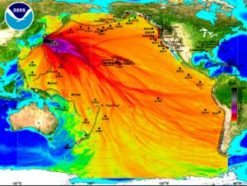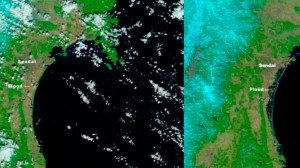Quake leaves destruction, fear
In Japan, an earthquake started a tsunami that caused a nuclear disaster

People in Japan face a catastrophe that has gone from terrible to tragic. The disaster began as an earthquake that launched a powerful ocean wave, called a tsunami, that caused destruction all along the coast. Those natural disasters damaged a cluster of nuclear reactors in Japan, leading to one of the worst nuclear disasters in recent years.
“My homeland has been struck by a tragedy of cataclysmic proportions. This has been one of the greatest natural disasters of modern times, the full extent of which is still becoming clear,” said Yukiya Amano, the director general of the International Atomic Energy Agency, in a press conference on March 14. “The events of the last few days are truly unprecedented.”
On the afternoon of Friday, March 11, an earthquake struck the floor of the Pacific Ocean 80 miles east of northern Japan. The U.S. Geological Survey reported the earthquake had a magnitude of 9.0, making it one of the most powerful in recent history. The magnitude of an earthquake is determined by measuring how strongly the Earth shook. People reported feeling the ground move all across the island country, both during the first quake itself and during hundreds of others that followed. Those later, smaller earthquakes are called aftershocks.
During the earthquake, the sea floor moved. That motion made the water go up and down and caused a tsunami, or a powerful ocean wave, that moved outward from the center of the earthquake site like the ripples that you see when a pebble drops in a pond. These ripples, though, were giant and spread out over the ocean.
Waves are how energy moves across the surface of the ocean, and when these waves struck Japan’s coast, they brought destruction. Within minutes, coastal towns flooded as unknown numbers of people were swept away with cars, boats and even buildings. Countries around the Pacific Ocean received tsunami warnings.
About 180 miles north of Tokyo, Japan’s capital city, two nuclear reactors were seriously damaged by the earthquake and tsunami. Although the reactors were equipped with safety devices intended to shut them down in case of an earthquake, the backup power supplies were also damaged by the quake and the tsunami. As a result, they failed.
The inside machinery of the reactors needs to be kept cool; if it’s not cool enough, a reactor could melt and possibly even destroy the protective metal vessel that encases the nuclear fuel. During a meltdown, radiation could be released into the air, threatening the health and safety of people nearby.
These nuclear reactors, part of a facility called Fukushima Daiichi, generate electricity for millions of people through a process called fission. During fission, a larger atom breaks into two or more smaller atoms. At most of the reactors at Fukushima Daiichi, atoms of an element called uranium-235 are the ones that break apart. Uranium-235 is natural on Earth, but it is unstable — which means it’s always ready to break apart. (The number 235 identifies how many protons and neutrons make up the nucleus, or heart, of a single atom.)
When an atom of uranium-235 fissions, it forms smaller atoms but also releases particles called neutrons. These particles can hit other atoms of uranium-235 and cause them to break apart — and then those newly split atoms release neutrons, which keep the reaction going and going. This is what occurs inside a nuclear reactor.
This reaction happens inside narrow rods that hold fuel pellets, which are immersed in water. As they undergo fission, the atoms inside the fuel rods produce heat. That heat will be transferred to water outside the reactor. As that water turns into steam, it is used to turns turbines that produce electricity.

Nuclear fission generates a lot of heat, so the nuclear reactors in which fission occurs need water to keep everything cool. At Fukushima Daiichi, which includes six reactors, water became the problem. According to the Nuclear and Industrial Safety Agency in Japan, the reactors lost power after the earthquake. That wasn’t a problem because backup generators started pumping water to remove heat building up inside the reactors. But when the tsunami struck, it took out those backup generators ― leaving the reactors dangerously hot. Then, another backup system, running on batteries, started. But it couldn’t keep up.
Explosions have seriously damaged other buildings associated with four of the reactors. A big and yet-unanswered question is whether it was the explosions or the excess heat in the reactor’s core that damaged the vessel that contains the fuel.
The core has become damaged. It appears to largely be holding the radioactive gases that have been developing. At times, however, reactor-safety teams have released small amounts of those radioactive gases to reduce the pressure in the vessel that holds the fuel.
Radiation levels around the reactors have become dangerous.
One reason is that old fuel rods from the six reactors at Fukushima Daiichi are stored near the reactors in pools of water. In many cases, those fuel rods are still quite hot. Circulating water is needed to cool these old fuel rods. But when the tsunami knocked out backup cooling to these pools, some lost much if not all of their water for a time. Under these conditions, radiation levels can increase enough to imperil the lives of workers. And on several occasions in the first week following the accident, many workers were sent home for their safety.
Some steam released from the reactors has also left the facility. Radiation from that steam has been detected in the countryside. Levels of radiation were not high, but because they could become high on short notice, people living within 20 kilometers of the reactor facility were told to evacuate. Those living between 20 and 30 kilometers of the plants were advised to stay indoors.
Even tinier amounts of radiation — levels almost too low to measure — have crossed the Pacific Ocean and been recorded in Washington State and California. As of March 21, these levels were too small to pose a risk to people living in the United States.
It will take months for Japanese officials to bring the reactors under control and for the country to dig out from the triple disaster that hit. Stay tuned.
POWER WORDS (adapted from the New Oxford American Dictionary)
Richter scale A way to measure the size of an earthquake, based on the measurements of seismographs. Destructive earthquakes typically have magnitudes of 5.5 or higher. A difference of one in the Richter scale represents an approximate 30-fold difference in magnitude.
seismograph A scientific instrument that measures the strength and duration of an earthquake.
tsunami A long, wide wave in the ocean caused by an earthquake or some other disturbance in the Earth.
fission The division or splitting of an atom into smaller atoms and into the particles that serve as building blocks of atoms.
radioactive Capable of producing ionizing radiation, which is powerful enough to remove electrons from other atoms.
uranium A gray, dense, radioactive element used in nuclear reactors.







